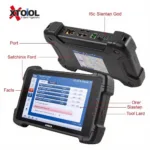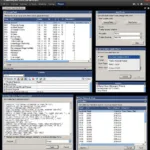Navigating the world of car diagnostics can feel like stepping into a labyrinth, especially with the constant advancements in automotive technology. Whether you’re a seasoned mechanic or a car enthusiast eager to troubleshoot your own vehicle, having the right diagnostic equipment is crucial. This comprehensive guide delves into the essential diagnostic equipments for cars, equipping you with the knowledge to make informed decisions for your specific needs.
Understanding the Importance of Car Diagnostic Equipments
Before we dive into the specifics, let’s address why car diagnostic equipments are indispensable. These ingenious tools act as your vehicle’s translator, deciphering the complex language of sensors, circuits, and electronic control units (ECUs). They provide valuable insights into your car’s health, allowing you to:
- Identify Problems Quickly and Accurately: Gone are the days of relying solely on guesswork. Diagnostic equipment pinpoint the root cause of issues, saving you time and costly misdiagnoses.
- Optimize Vehicle Performance: By monitoring vital parameters like engine timing, fuel pressure, and emissions, you can ensure your car operates at peak performance.
- Prevent Costly Repairs: Detecting minor issues early on can prevent them from snowballing into major, expensive repairs down the road.
Essential Diagnostic Equipments for Cars: A Closer Look
The market offers a diverse range of diagnostic equipments for cars, each tailored to specific functions. Let’s explore some of the must-have tools:
1. OBD-II Scanners: Your Gateway to the Car’s Brain
The OBD-II (On-Board Diagnostics) scanner is arguably the most fundamental tool in a car diagnostic arsenal. This handheld device plugs into your car’s OBD-II port, typically located under the dashboard, and communicates with the ECU.
- Reading and Clearing Diagnostic Trouble Codes (DTCs): When the check engine light illuminates, the OBD-II scanner reveals the specific DTC stored in the ECU, providing clues about the underlying issue.
- Accessing Live Data Stream: Witness your car’s vital signs in real-time! OBD-II scanners display live data from various sensors, including engine RPM, coolant temperature, and oxygen sensor readings.
Choosing the Right OBD-II Scanner:
From basic code readers to advanced scan tools with bi-directional control, the options can seem overwhelming. Consider your skill level and diagnostic needs.
- DIYers: A basic code reader that displays and clears DTCs might suffice.
- Car Enthusiasts: Opt for a mid-range scanner with live data streaming capabilities.
- Professional Mechanics: Invest in a professional-grade scan tool offering advanced features like bi-directional control, graphing, and data logging.
2. Multimeters: The Electrical System’s Detective
Electrical gremlins can be frustrating to diagnose. Enter the multimeter, a versatile tool that measures voltage, current, and resistance. It’s your go-to instrument for troubleshooting electrical issues in your car.
- Testing Battery Voltage: Ensure your battery is healthy and delivering the required power.
- Checking for Continuity: Identify broken wires, faulty fuses, and bad connections.
- Measuring Resistance: Diagnose issues with sensors, solenoids, and other electrical components.
3. Oscilloscopes: Capturing the Invisible Electrical Signals
For advanced diagnostics, especially when dealing with complex electronic systems, an oscilloscope is invaluable. This sophisticated tool visualizes electrical signals as waveforms, revealing subtle fluctuations that multimeters might miss.
- Diagnosing Ignition System Problems: Analyze spark plug firing patterns, coil output, and other ignition components.
- Troubleshooting Sensor Signals: Verify the integrity of signals from sensors like crankshaft position sensors and camshaft position sensors.
- Analyzing Communication Networks: Diagnose issues with CAN (Controller Area Network) and other communication systems.
4. Pressure Gauges: Unveiling the Mysteries of Fluid Systems
Many automotive systems rely on fluids under pressure, such as the fuel system, cooling system, and braking system. Pressure gauges come in handy for diagnosing leaks, blockages, and other issues within these systems.
- Fuel Pressure Testing: Ensure the fuel pump delivers adequate pressure to the engine.
- Cooling System Pressure Testing: Check for leaks in the radiator, hoses, and water pump.
- Brake System Bleeding: Remove air bubbles from the brake lines to ensure optimal braking performance.
Conclusion: Empowering Yourself with the Right Diagnostic Equipments for Cars
Investing in the right diagnostic equipments for cars is an investment in your peace of mind. Whether you’re a DIYer tackling simple repairs or a professional mechanic diagnosing complex issues, these tools provide the insights you need to keep your car running smoothly.
Remember, the best diagnostic equipment is the one that aligns with your skill level and specific needs. Take the time to research and choose wisely.


